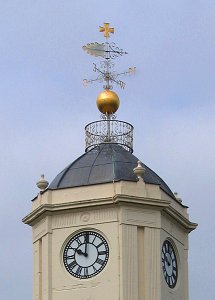 |
Wolverhampton's Listed Buildings
St. Leonard's
Church Street, Bilston
|
 |
|

Listing: 1825-6. By Francis Goodwin, restored 1882-3 by Ewan
Christian. Neo-classical style, influenced by Soane. Interior mostly by
Christian.
Also listed are Beard's monument, Gallimore's monument and Smith's monument.
Pevsner: The very hub of the town. A medieval foundation rebuilt by
Francis Goodwin in 1825-26 to a classical, not a Gothic, design. The present
rendering is of 1882-3. ... set into the doorway are two cast iron objects which
may remind one of bollards....
Literature: George Lawley's History of Bilston, 1893, contains
information about the church, scattered throughout. He is a rather idiosyncratic
observer.
Comment: Lawley refers to "the present structure, with its
hideous pepper-box tower ...". He argues, from the church records and his
inspection of the building, that the lower part of the earliest tower was never
fully demolished and the present tower therefore still incorporates part of the
14th century tower. (p.105 and p p.179).
 |
| Read Brian
Lockley's history of the church |
|
 |
As to Goodwin's rebuilding, Lawley gives details
from the church accounts and then records (p.178):
"... the parishioners resolved to engage Mr. G. Goodwin,
architect, of London, to prepare plans for the enlargement, and
on Feb. 12, 1824, the plans were submitted, approved, and £30
paid to the architect for them. At a vestry meeting held June
20, 1825, it was resolved to accept the offer of the Society for
the Promoting and the Enlargement and Building of Churches, to
give £550 on condition that a certain number of seats were free.
That an additional rate of 1s. in the pound for five years be
levied to make up the deficiency between the above grant and the
cost of alterations, estimated to be £2,600."
Francis Goodwin also did St.
Mary's, in Oxford Street, which is Gothic, not classical. |
| In fact the cost of the building alone turned out
to be £8263. 16s. 8d.. The Society was a voluntary body which
distributed publicly raised funds and worked closely with the
Church Commissioners who distributed government funds for the
same purpose. As to Christian's restoration work, Lawley
records the fact that the curate of St. Leonard's was popularly
elected and often this lead to rioting and other unseemly
behaviour. Then: |
| "The excitement and undignified incidents of an
election for so sacred an office were so painfully out of
harmony with the spirit of the times, that many earnest persons,
both churchmen and dissenters, felt the urgent desirability of
putting an end to this anomaly. Steps were taken to vest the
right of presentation in different hands, and Mr. Edward Pugh
offered to purchase the advowson for £3000, on condition the
church was restored out of the sum, and the balance invested,
the interest thereof to be applied to a reduction of the rates,
the sale to take place under the provisions of Sir Smith Child's
Act. The sale was completed, with the consent of the town, in
1881, and the restoration commenced, the plans being prepared
under the supervision of Mr. Ewan Christian, the eminent
Ecclesiological Architect, and the builders, Messrs. Higham, of
Wolverhampton. The living is now vested in the hands of five
Trustees ...". |
 |
 |
The interior contains these two ceramic memorials.
This type of memorial is rare in this area, despite its
proximity to the Potteries. |
 |
 |
Outside in the churchyard are many interesting
memorials, in addition to those listed, including this one
to the Hickman family. |
| And this one with black and white glazed bricks in a
chequer pattern. When new it must have looked quite
startling. |
 |

|
But the churchyard also contains grave markers in the
form of great iron slabs with only a name and date stamped or cast into
them, set in the church path and yard. They are very unusual.
There are several more in the other Bilston C of E church, St Mary's.
Presumably they reflect Bilston as an iron town. Iron Mad Wilkinson
operated in Bilston and these grave markers would accord with his
principle of using iron for everything - he was buried in an iron
coffin. |
|
The top of the tower is most decorative and is a landmark
for far around.
|
 |

|